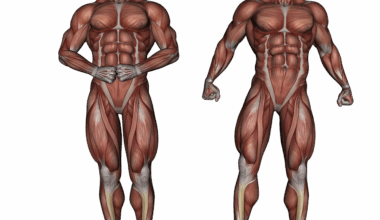Benefits of Cardiovascular Exercise for Joint Health and Mobility
Cardiovascular exercise significantly enhances joint health and mobility, offering numerous benefits that can improve one’s quality of life. It achieves this through improved circulation, which brings essential nutrients to joint tissues. Stronger muscles surrounding joints provide better support, reducing the likelihood of injuries, and enhancing functionality. Regular aerobic activities such as running, cycling, or swimming lead to increased flexibility and strength of the muscles involved in joint movement. The daily activity facilitates better range of motion, making everyday movements easier and less painful. Proper cardiovascular activities can also help individuals maintain a healthy weight, reducing strain on the joints. By minimizing excess body weight, particularly around the knees and hips, cardiovascular exercise decreases the risk of joint pain and osteoarthritis. Moreover, endorphins released during aerobic exercise act as natural painkillers. This helps to alleviate chronic pain symptoms, creating an opportunity for individuals to engage in other forms of physical activity. Embracing a routine filled with cardiovascular workouts contributes to long-term joint health and can enhance overall mobility, leading to a more active and fulfilling lifestyle.
This type of exercise promotes the lubrication of joints, making movements smoother and more comfortable. Engaging in cardiovascular activities encourages the production of synovial fluid, which surrounds joints and allows for frictionless motion. Less friction translates into reduced wear and tear on the joints over time. As the joints become more frequently lubricated, there’s a significant reduction in stiffness and discomfort often associated with sedentary lifestyles. Additionally, cardiovascular exercise helps in maintaining bone density, which supports joint stability. Strengthening bones provides a more robust structure for joints to function properly. The cumulative effects of consistent cardiovascular training foster resilience against injuries. Besides physical improvements, cardiovascular workouts contribute to mental health, releasing stress and anxiety, which can psychologically enhance mobility and enthusiasm for activities. For those with existing joint conditions, low-impact cardiovascular activities, such as swimming or biking, are advantageous as they present minimal joint stress while allowing for effective heart rate elevation. Transitioning towards a more active lifestyle through cardiovascular exercises can create a powerful, positive feedback loop for maintaining health and improving daily life physicalities.
Enhancing Posture and Balance
Building cardiovascular fitness positively influences posture and balance, both crucial aspects of mobility and joint health. Engaging in activities like walking, running, or dancing enhances core strength and stability, crucial for maintaining proper posture. Good posture takes strain off joints and lowers the risk of injuries. Furthermore, balanced core muscles ensure the body is aligned correctly, preventing undue stress on joints during physical activities. Enhanced balance reduces the likelihood of falls and associated injuries, particularly in the elderly population. Such cardiovascular exercises improve proprioception, which is the body’s sense of its position in space. Improved proprioceptive ability allows individuals to react appropriately to changes in their environment or activities, resulting in safer movement patterns. Additionally, the coordination fostered through aerobic workouts is essential in executing various physical tasks seamlessly. While some might perceive cardiovascular exercise as merely aerobic, its benefits extend beyond heart health. It is immensely valuable for developing muscular endurance, which supports joint movements over time. Thus, consistent engagement in cardiovascular activities is essential in creating a solid foundation for enduring mobility and healthy joints.
Moreover, cardiovascular exercise is pivotal in enhancing mental alertness and emotional well-being. Mental clarity gained from aerobic activities can positively influence motivation, creating an impetus to engage in more physical activities, including strength training and flexibility exercises. Since psychological wellness is intricately connected with physical activity, a stable mental state can reduce the perception of pain. Decreased anxiety and stress support healthier joint function, especially for those suffering from chronic pain or joint disorders. Moreover, knowledge of how cardiovascular fitness promotes joint longevity may lead individuals to adopt more active lifestyles. When individuals witness the benefits from different cardiovascular activities, they often seek various exercise types, increasing overall engagement. Programs focusing on community workouts further foster social connections, enabling individuals to exercise with support and shared encouragement. The collaborative aspect of group cardiovascular activities can substantially improve exercise adherence and lifestyle changes. A thriving community environment contributes to shared goals and experiences, promoting a healthier collective wellbeing. Thus, cardiovascular fitness is essential not only for joint health but also for fostering mental resilience that cultivates a more vibrant and active life.
Long-Term Joint Health Management
Incorporating cardiovascular exercise into a regular routine is vital for long-term joint health management. It serves as a preventive strategy against joint pain and degeneration, which may occur as individuals age. Engaging in low-impact cardiovascular activities helps maintain joint function while avoiding undue stress, ensuring seniors retain their mobility with fewer obstacles. Additionally, early intervention through cardiovascular exercises can mitigate future orthopedic issues, meaning the longer one engages in such activities, the more protective benefits accrue for the joints. The adaptability of cardiovascular workouts is beneficial as individuals can modify intensity and focus based on their unique fitness levels and joint conditions. Options range from gentle walks to more vigorous cycling sessions, allowing for individualized plans targeting specific needs and preferences. The beauty lies in the versatility of adhering to personal needs while still gaining the immense benefits for joint health. Lightweight rebounds can enhance cardiovascular output without over-exerting already compromised joints, proving vital for chronic sufferers. Therefore, considering the lasting advantages of adopting cardiovascular exercise remains invaluable for promoting enduring joint health and mobility.
Additionally, education plays a critical role in utilizing cardiovascular exercise effectively for joint health. Understanding the nuances of proper exercise forms, such as the correct running technique, helps avoid injuries that might arise due to poor practice. Knowledge about suitable cardiovascular options allows individuals with pre-existing joint issues to select safe exercise methods while staying active. Essential skills in self-assessment also empower individuals to determine pain thresholds, adjusting workouts accordingly. Implementing regular fitness assessments can maintain motivation by tracking the progress made regarding cardiovascular fitness and joint functionality. Metrics such as improved endurance or reduced stiffness serve as motivators for continued participation. Furthermore, working alongside fitness professionals to develop tailored cardiovascular routines can dramatically enhance personal accountability and ensure exercises remain within safely tolerated limits. Guidance from trainers ensures optimal use of exercises aligning specifically with improving joint health. In this essential journey toward better mobility, informed practice is equally as vital as exercise itself. Consequently, the combination of knowledge and exercise becomes a formidable instrument for advancing joint health while promoting a lifetime of physical activity.
Conclusion
In conclusion, cardiovascular exercise offers extensive benefits significant to joint health and mobility, promoting a proactive approach to lifelong fitness. Improved blood circulation enhances joint lubrication, decreasing stiffness and pain often found in inactive lifestyles. Engaging in regular cardiovascular activities promotes stronger muscles, which provide essential support for joints, decreasing the risk of injury. Moreover, improved flexibility and mobility facilitate easier day-to-day movements, contributing to a more active lifestyle. Enhancing posture and balance through such exercise positively affects joint stability, critical for reducing fall risks among older adults. Furthermore, the mental and emotional advantages stemming from aerobic activities encourage more consistent physical engagement, balancing physical and psychological well-being. Emphasizing the long-term strategies of cardiovascular exercise allows individuals to manage their joint health effectively while enjoying the numerous associated physical rewards. In addition, staying educated and informed about cardiovascular practices fosters greater self-reliance for making beneficial health choices. Society must acknowledge the imperative nature of cardiovascular fitness and use its extensive benefits for joint health, leading to active and fulfilling lives throughout all stages of life.
Ultimately, cardiovascular exercise should be a fundamental component of any fitness regimen, especially for those concerned about joint health. Investing time into discovering enjoyable aerobic activities can open doors to new social circles, enhancing both physical and emotional experiences. People who prioritize such fitness often find themselves in greater harmony with their bodies, effectively cultivating resilience and adaptability. Choosing to incorporate cardiovascular elements into daily habits offers lasting advantages through improved mobility and enhanced quality of life. The transformative power of cardiovascular fitness is profound, emerging as a vital staple in the journey toward maintaining optimal joint health. It undoubtedly becomes a lifelong commitment, rewarding individuals with not only physical health benefits but also enriching life experiences that can last a lifetime.


